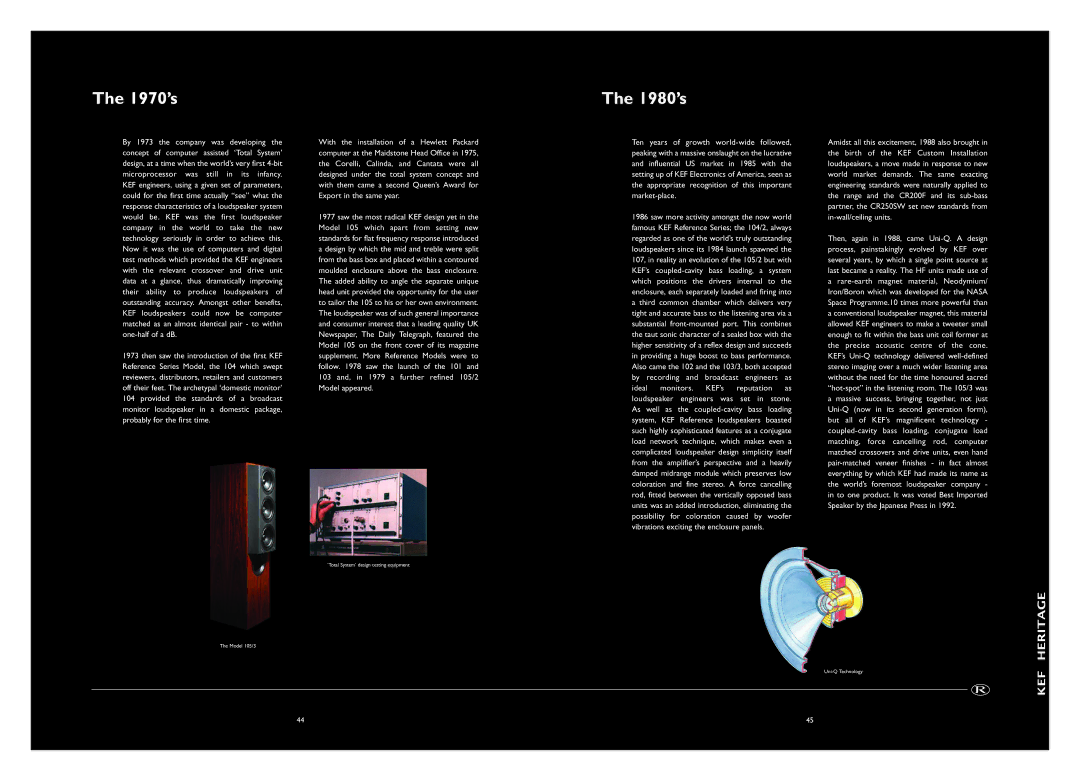The 1970’s
By 1973 the company was developing the concept of computer assisted ‘Total System’ design, at a time when the world’s very first 4-bit microprocessor was still in its infancy. KEF engineers, using a given set of parameters, could for the first time actually “see” what the response characteristics of a loudspeaker system would be. KEF was the first loudspeaker company in the world to take the new technology seriously in order to achieve this. Now it was the use of computers and digital test methods which provided the KEF engineers with the relevant crossover and drive unit data at a glance, thus dramatically improving their ability to produce loudspeakers of outstanding accuracy. Amongst other benefits, KEF loudspeakers could now be computer matched as an almost identical pair - to within one-half of a dB.
1973 then saw the introduction of the first KEF Reference Series Model, the 104 which swept reviewers, distributors, retailers and customers off their feet. The archetypal ‘domestic monitor’ 104 provided the standards of a broadcast monitor loudspeaker in a domestic package, probably for the first time.
With the installation of a Hewlett Packard computer at the Maidstone Head Office in 1975, the Corelli, Calinda, and Cantata were all designed under the total system concept and with them came a second Queen’s Award for Export in the same year.
1977 saw the most radical KEF design yet in the Model 105 which apart from setting new standards for flat frequency response introduced a design by which the mid and treble were split from the bass box and placed within a contoured moulded enclosure above the bass enclosure. The added ability to angle the separate unique head unit provided the opportunity for the user to tailor the 105 to his or her own environment. The loudspeaker was of such general importance and consumer interest that a leading quality UK Newspaper, The Daily Telegraph, featured the Model 105 on the front cover of its magazine supplement. More Reference Models were to follow. 1978 saw the launch of the 101 and 103 and, in 1979 a further refined 105/2 Model appeared.
The 1980’s
Ten years of growth world-wide followed, peaking with a massive onslaught on the lucrative and influential US market in 1985 with the setting up of KEF Electronics of America, seen as the appropriate recognition of this important market-place.
1986 saw more activity amongst the now world famous KEF Reference Series; the 104/2, always regarded as one of the world’s truly outstanding loudspeakers since its 1984 launch spawned the 107, in reality an evolution of the 105/2 but with KEF’s coupled-cavity bass loading, a system which positions the drivers internal to the enclosure, each separately loaded and firing into a third common chamber which delivers very tight and accurate bass to the listening area via a substantial front-mounted port. This combines the taut sonic character of a sealed box with the higher sensitivity of a reflex design and succeeds in providing a huge boost to bass performance. Also came the 102 and the 103/3, both accepted by recording and broadcast engineers as ideal monitors. KEF’s reputation as loudspeaker engineers was set in stone. As well as the coupled-cavity bass loading system, KEF Reference loudspeakers boasted such highly sophisticated features as a conjugate load network technique, which makes even a complicated loudspeaker design simplicity itself from the amplifier’s perspective and a heavily damped midrange module which preserves low coloration and fine stereo. A force cancelling rod, fitted between the vertically opposed bass units was an added introduction, eliminating the possibility for coloration caused by woofer vibrations exciting the enclosure panels.
Amidst all this excitement, 1988 also brought in the birth of the KEF Custom Installation loudspeakers, a move made in response to new world market demands. The same exacting engineering standards were naturally applied to the range and the CR200F and its sub-bass partner, the CR250SW set new standards from in-wall/ceiling units.
Then, again in 1988, came Uni-Q. A design process, painstakingly evolved by KEF over several years, by which a single point source at last became a reality. The HF units made use of
arare-earth magnet material, Neodymium/ Iron/Boron which was developed for the NASA Space Programme.10 times more powerful than a conventional loudspeaker magnet, this material allowed KEF engineers to make a tweeter small enough to fit within the bass unit coil former at the precise acoustic centre of the cone. KEF’s Uni-Q technology delivered well-defined stereo imaging over a much wider listening area without the need for the time honoured sacred “hot-spot” in the listening room. The 105/3 was a massive success, bringing together, not just Uni-Q (now in its second generation form), but all of KEF’s magnificent technology - coupled-cavity bass loading, conjugate load matching, force cancelling rod, computer matched crossovers and drive units, even hand pair-matched veneer finishes - in fact almost everything by which KEF had made its name as the world’s foremost loudspeaker company - in to one product. It was voted Best Imported Speaker by the Japanese Press in 1992.

